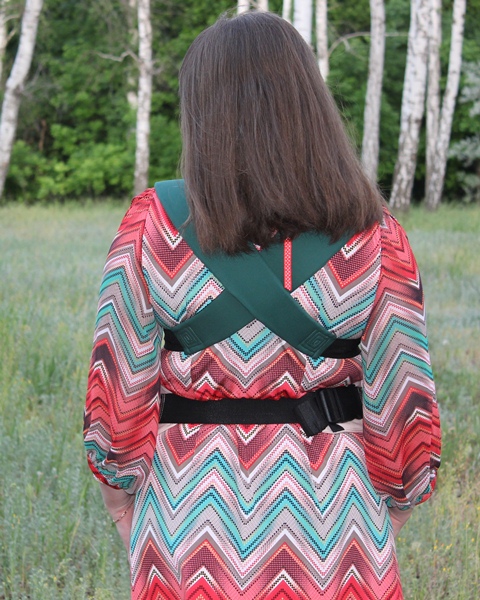How and what kind of an ergonomic baby carrier to choose?
We’ve already found out that ergonomic baby carriers are nice and useful while kangaroo carriers are harmful, as well as we know how to distinguish them. Currently lots of different carriers are available for sale, but how to understand that a carrier is comfortable and what features should be considered?
- Fabric for an ergonomic baby carrier should not be heavy. You need to check if a carrier is made of 100% cotton and has no thermal insulation inside. Babies may feel hot and thus sweat in heavy-wefted carriers. Some manufacturers provide a pocket on carrier’s back to fold a hood in, and this makes a carrier back even hotter. It is better to choose ergonomic baby carriers with a hood folded and fixed in such a manner that it doesn’t make a carrier’s back heavier or choose one with a completely detachable hood.
- Both parallel and cross-wearing of carrier shoulder straps.A carrier with both parallel and cross shoulder straps design allows you choosing convenient way of carrying. Babies grow up and become heavier day after day. Cross-wearing distributes the load between shoulders and back. When cross-wearing, the straps clips are located on sides – such carrier is easier to wear and remove unaided. When parallel-wearing, the straps clips are located in the middle of the back just above shoulder-blades. It is usually less convenient to wear and take off such a carrier for most mummies. However, all things are very individual, so if a carrier provides both wearing positions, then it is absolutely an advantage.


- Long carrier shoulder straps. When buying a carrier, it is necessary to account for equal convenience both for Moms and Dads! Make sure that the shoulder straps are long enough and are suited for a Dad’s broad back. It will be great if the soft parts of the shoulder straps but not bands, in case of cross-wearing, will cross over at the crossing area. Then the load will be better distributed over the back and it will be more comfortable for you.
- Three carrying positions. Choose an ergonomic baby carrier with front (facing in), hip and back carrying options. Don’t opt for facing out position, because it is not ergonomic and safe for baby’s health. An ergonomic position is the position when a baby “hugs” its mother with widely spread legs, while the baby’s buttocks should be below the knees (”M position”) and the baby's back should be relaxed and slightly rounded. In facing out position a baby can’t round its back naturally –baby's back is always straight that way, the lower spine is then under pressure affecting baby's health and physiological growth.
- Proper dart under the buttocks. Usually, an ergonomic baby carrier is purchased with the purpose of assistance until the baby begins to walk without somebody’s help. But even when the baby walks, there are situations when a baby carrier may be necessary. Therefore, when choosing a baby carrier, it is desirable to account for the option of using it for a grown-up baby. Different baby carriers provide an option of carrying babies weighing up to 15-25 kg, but not all of them provide ergonomic and comfortable position of a baby when it almost reaches to the maximum allowed weight. Consider if the dart under the baby's buttocks is suitable and how deep is a baby squatted in the ergonomic baby carrier. It is supposed that in a baby carrier with no specified place for buttocks the baby will not sit up in the ergonomic position by 12 months - knees and buttocks will be on the same level, but that is not physiologic! Such position is especially forbidden for babies who can’t sit up independently.

